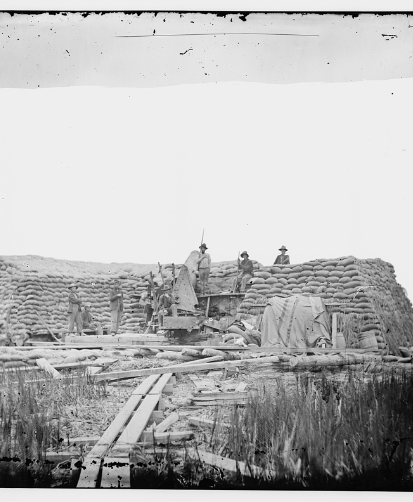SWAMP ANGEL
This essay has been adapted from Lost Charleston.
Read more about this amazing engineering feat in the Post & Courier's "Do You Know Your Lowcountry" column.
In the summer of 1863, Union Maj. Gen. Quincy Gillmore attempted to take Charleston using one of the most impressive weapons of its day: an 11-foot long Parrot gun with an 8-inch barrel that could fire 150-pound shells more than a mile and a half with reasonable accuracy. His men called it the Swamp Angel. Including its carriage, it weighed 24,000 pounds.
The challenge was where and how to mount the monstrosity. Using St. Michael’s steeple as his target, Gillmore needed to station the gun in a spot between James and Morris islands that was nothing but marsh and pluff mud – an environment hardly conducive for a 12-ton cannon. His chief engineer proclaimed it was impossible. Undaunted, he asked Col. Edward Serrell of the 1st New York Engineers to take on the challenge.
Serrell accomplished the impossible, building a “floating battery” on pilings driven deep into the pluff mud. In the August heat, with Confederate troops on James Island firing upon them, the soldiers carried by hand, 123 logs, 13,000 sandbags weighing more than 800 tons, 600 pounds of iron, and 75 fathoms of rope along a narrow 1,700-foot causeway. The miraculous engineering feat had been accomplished in just seven days.
On the moonless night of Aug. 17, the Swamp Angel was loaded onto a boat so burdened by the gun’s weight that it perilously floated only inches above the waterline. The trip was slow and required a lot of bailing, but in the end the Swamp Angel was successfully transported to the battery.
On Aug. 21 around 10:45 p.m., Gillmore sent word to Confederate Gen. P.G.T. Beauregard demanding the city’s surrender. Beauregard never received the message, however: Gillmore had not signed his note, therefore Beauregard’s staff declared it invalid and sent it back. Meanwhile, as Gillmore hadn’t heard back from Beauregard by the midnight deadline, he began firing around 1:30 a.m. Sixteen of the Swamp Angel’s shells, some filled with “Greek fire” that would explode upon impact, wreaked havoc on the city throughout that horrific night.
British journalist Frank Vizetelly wrote a horrifying, though a bit humorous, report of the evening’s pandemonium at the Charleston Hotel on Meeting Street, where he was a guest. He describes terrified guests who had just jumped out of bed rushing into the hotel’s hallway: “One perspiring individual of portly dimensions was trotting to and fro with one boot on and the other in his hand, and this was all the dress he could boast of.”
Vizetelly and other guests passed the night betting where the next shell would hit. A fellow guest recalled: “We could hear the whiz of the shells before they passed over our heads, and I bet the Englishman a thousand to one that the next shell would not hit us. He took the odds, forgetting that if he won he would be unable to collect his wager, and of course, I won my dollar.”
Later that morning, Gillmore’s note, now signed, was delivered to Beauregard, who responded contemptuously of Gillmore’s bombardment of a city that harbored mostly women and children, unarmed slaves and old men. Gillmore granted civilians the rest of that day and the next to evacuate before firing again the following night, Aug. 23.. This time several shells exploded while still inside the gun, compromising its structure. Yet Gillmore’s men continued, using a lanyard to set the charge while they sought protection behind sandbags. On its 20th shot, the Swamp Angel exploded in a giant fireball.
Its remains were sold as scrap after the war. On its way to being melted down, however, someone recognized the gun and saved it. Today the Swamp Angel’s barrel is displayed at Cadwalader Park in Trenton, N.J. What’s left of its miraculous battery, now barely discernable to an untrained eye, is preserved by the S.C. Battleground Preservation Trust.





